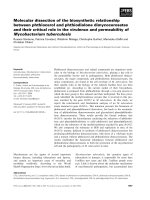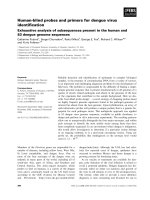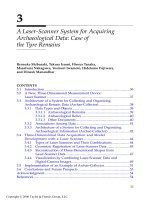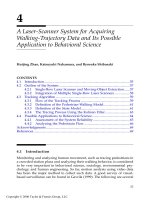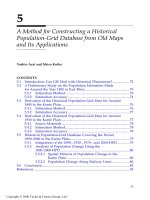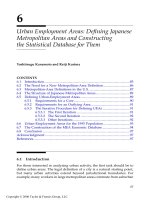GIS Based Studies in the Humanities and Social Sciences - Chpater 5 doc
Bạn đang xem bản rút gọn của tài liệu. Xem và tải ngay bản đầy đủ của tài liệu tại đây (1.14 MB, 13 trang )
71
5
A Method for Constructing a Historical
Population-Grid Database from Old Maps
and Its Applications
Yoshio Arai and Shiro Koike
CONTENTS
5.1 Introduction: Can GIS Deal with Historical Phenomena? 72
5.2 A Preliminary Study on the Population Estimation Made
for Around the Year 1890 in East Biwa 73
5.2.1 Estimation Method 73
5.2.2 Estimation Accuracy 74
5.3 Derivation of the Historical Population-Grid Data for Around
1890 in the Kanto Plain 76
5.3.1. Estimation Method 76
5.3.2 Estimation Accuracy 77
5.4 Derivation of the Historical Population-Grid Data for Around
1930 in the Kanto Plain 77
5.4.1 Source Materials 78
5.4.2 Estimation Method 78
5.4.3 Estimation Accuracy 78
5.5 Historical Population-Grid Database Covering the Period
1890–2000 in the Kanto Plain 79
5.5.1 Integration of the 1890-, 1930-, 1970-, and 2000-HPD 79
5.5.2 Analysis of Population Change Using the
1890–2000-HPD 80
5.5.2.1 Spatial Patterns of Population Change in the
Kanto Plain 80
5.5.2.2 Population Change Along Railway Lines 80
5.6 Conclusion 82
References 83
2713_C005.fm Page 71 Thursday, September 15, 2005 6:23 AM
Copyright © 2006 Taylor & Francis Group, LLC
72
GIS-based Studies in the Humanities and Social Sciences
5.1 Introduction: Can GIS Deal with Historical Phenomena?
Owing to recent progress made in the refinement of geographic information
systems (GIS), spatial analysis using GIS is penetrating human and social
sciences, such as economics, sociology, archaeology, and human geography.
However, many studies using GIS in these fields are concerned with rela-
tively recent phenomena that have occurred in the last two or three decades.
Few studies deal with long-term events, such as urban growth during the
social modernization process of the past 100 years.
Although it is considered that a detailed spatio-temporal analysis of the
long-term development of urban areas provides some valuable insights into
the nature of cities, severe difficulties are encountered using GIS to study
this process. The largest problem is the lack of suitable detailed historical
spatial data.
Can GIS really deal with historical phenomena? The only way to make it
possible is by digitizing contemporary maps and documents. A few studies
have attempted to adapt historical data to be suitable for GIS. Pioneering
work in this field was undertaken by Norton (1976), who reconstructed land-
use data for a township in Canada. A recent example of research by Lee
(1996) is a quantitative analysis of population distribution in Northern Ire-
land during the 19th century. More recently, Taniuchi (1995) estimated the
population-grid data for Tokyo around the year 1900, using various statistical
materials. Siebert (2000) reconstructed with GIS the infrastructure patterns
of pre–World War II Tokyo using old maps. These studies, however, have a
limitation in that they generally focused upon a small area at one point in
time and did not cover a much larger area over a long period.
In this chapter, we propose a method for constructing
historical population-
grid data
(HPD) from old topographical maps. The method is designed to
overcome limitations found in previous studies. Topographical maps, which
were made in accordance with an authorized format for survey publications,
illustrate geographical features across a wide area. From them we can see
the detail of urban and rural areas at the time of map production. Can we
derive from these old maps numerical data on the population distribution
in those days?
Herein, we have attempted to assemble historical population-grid data
from around 1890 (1890-HPD) and that from about 1930 (1930-HPD). These
data, together with modern statistics, have been used to make a time-series
dataset for intervals of less than 40 years, covering the 110-year period from
the close of the 19th century. This dataset is valuable for spatio-temporal
analysis of the changing pattern of population throughout the period from
the beginning of the Japanese modern era to the present day.
The chapter consists of six sections, including this introductory Section
5.1. A preliminary study in Section 5.2 gives a systematic sampling method
for estimating population from an area occupied by housing. By modifying
2713_C005.fm Page 72 Thursday, September 15, 2005 6:23 AM
Copyright © 2006 Taylor & Francis Group, LLC
A Method for Constructing a Historical Population-Grid Database
73
this method, the 1890-HPD is made for the Kanto Plain area in Section 5.3.
Section 5.4 constructs the 1930-HPD in the same area, but the manner of
derivation is further modified, because the source materials were different.
Section 5.5 integrates the 1890-HPD and the 1930-HPD with the population-
grid data published by the Statistical Bureau of Japan for 1970 and 2000.
Section 5.5 also shows two applications of the integrated 1890-2000 HPD to
population studies. The chapter ends in Section 5.6 with suggestions for
further work.
5.2 A Preliminary Study on the Population Estimation Made
for Around the Year 1890 in East Biwa
To derive the historical population-grid data (HPD) for the Kanto Plain
between the years 1890–2000, we carried out the preliminary study for East
Biwa shown in this section.
5.2.1 Estimation Method
The means of estimating population from topographical maps published in
1890 is based on the method proposed by Arai and Koike (2003) and Koike
and Arai (2001). It is assumed that in 1890 almost all the buildings in villages
shown on the maps were single story, and that the family structure was not
very varied among settlements. In consequence, the total area occupied by
buildings and the number of residents in a village were closely related. From
these assumptions, we derived the hypothesis that population
P
can be
expressed as a function of the area of buildings
A,
appearing on topograph-
ical maps, i.e.,
P
=
f
(
A
) (5.1)
To measure the area of buildings efficiently, the systematic point-sampling
method was used. We overlaid a scale grid of 20-meter intervals on a map
and regarded the lattice points as systematic sample points. The number of
such points included in the area of buildings was counted (Figure 5.1). Let
N
be the number of sample points included in the area of buildings. As
N
is proportional to
A
,
A
is substituted by
N
and Equation (5.1) is written as
P
=
f
(
N
) (5.2)
Let us see if the relationship of Equation (5.2) really holds, using empirical
data. The study area is fully named the “East-
Biwako
Area” located in the
central part of Honshu, the main island of Japan. Old
Seishikizu
topographical
2713_C005.fm Page 73 Thursday, September 15, 2005 6:23 AM
Copyright © 2006 Taylor & Francis Group, LLC
74
GIS-based Studies in the Humanities and Social Sciences
maps cover the whole area at a scale of 1/20,000, and these show the geo-
graphical features existing in 1890.
Shigaken Bussanshi
, a statistical report,
was made at almost the same time as the maps. Actual population numbers
by village are given in this report.
We related the number of sample points included in the area of buildings
to the population data. The relationship between the actual population of
each village
P
, and the number of sample points within the mapped build-
ings in that village
N
, is shown in Figure 5.2. This figure shows a clear
correlation between
N
and
P
. A regression analysis provided the following
equation:
log
(
P
)
=
1.3008
N
0.1634
(5.3)
The fact that the squared correlation coefficient for this regression equation
was 0.8304 is positive evidence that there is a close relationship between
P
and
N,
represented by Equation (5.2).
The spatial unit used in Equation (5.3) was a village area, but any spatial
unit can be used. In the HPD in East Biwa, square 1 km
2
cells are used, and
these are also employed in the
Basic Grid-Square
(BGS) system, which is now
extensively used for GIS-based spatial analysis in Japan.
5.2.2 Estimation Accuracy
The accuracy of the population estimation made above is next examined.
We obtained the actual population of each square cell directly from the
historical report. As a result, the estimated and actual population of each
cell was available for comparison. Figure 5.3 shows the distribution of errors.
The percentage of cells having an error within 20 percent was more than 60
percent of the total.
FIGURE 5.1
An example of point-sampling.
0 100 200 m
Circles represent sample points
2713_C005.fm Page 74 Thursday, September 15, 2005 6:23 AM
Copyright © 2006 Taylor & Francis Group, LLC
A Method for Constructing a Historical Population-Grid Database
75
An uneven geographical distribution of error was found. The error rate
seemed to differ between individual map sheets. This unevenness was
caused by an arbitrary cartographic representation of villages or of buildings,
resulting from a lack of standardization in map ornament at the time of map
drafting.
We attempted to reduce the uneven errors by considering the statistical
characteristics of the Chinese lettering size used for village names written
on the maps, and this adjustment allowed us to reduce the error rate. The
detail of this technique is seen in Koike and Arai (2001). The percentage of
cells with an error within 20 percent was increased to 70 percent of the total,
and the percentage of cells with an error of more than 40 percent was
significantly reduced.
FIGURE 5.2
Relationship of
N
and
P
in logarithmic scale (taken from Arai and Koike, 2003).
FIGURE 5.3
Distribution of the error rate in the estimated grid population (taken from Arai and Koike, 2003).
log (P) = 1.3008N
0.1634
R
2
= 0.8304
0
1
2
3
4
0 0.5 1 1.5 2 2.5 3
log (N )
log (P)
0
50
100
150
−50%
−50%
−40%
−30%
−20%
−10%
0%
+10%
+20%
+30%
+40%
+50%
Estimation error
Number of square cells
2713_C005.fm Page 75 Thursday, September 15, 2005 6:23 AM
Copyright © 2006 Taylor & Francis Group, LLC
76
GIS-based Studies in the Humanities and Social Sciences
5.3 Derivation of the Historical Population-Grid Data
for Around 1890 in the Kanto Plain
The method used above for estimating HPD in East Biwa is rather simple, but
it contains several time-consuming processes, for example, the adjustment for
the arbitrary drawing of buildings, which is difficult to automate. Many basic
GIS tools can reduce work time. We tried to develop and test several methods
for HPD estimation using GIS tools. The manner of derivation of HPD for
around 1890 (1890-HPD) in the Kanto Plain will be introduced in the following
section.
5.3.1. Estimation Method
A basic resource in the HPD derivation was the
Jinsokuzu
map series. In these
maps, where the concentration of buildings is low, each building is drawn
separately. Where the concentration is high, adjacent buildings are drawn as
a single, combined area. We represented concentrated areas as polygons. How-
ever, the number of separated buildings was too many to represent in this
way, there being so many that the digitizing would have been very time
consuming. To avoid this task, separated buildings were located as circles with
an 8-meter radius centered upon them. This gave the average area occupied
by a building and the resulting digitized data forms a vector-layer of buildings.
Systematic sample points were generated with a 25-meter-wide grid over the
vector-layer of buildings. Points placed in the concentrated areas of buildings
were referred to as
Type A
, and those placed in the circles as
Type B
.
Population was estimated using a multiple-regression model. The depen-
dent variable of the model is the population of each village
P,
which was
obtained from a statistical report called
Chohatsu Bukken Ichiranhyo
. The inde-
pendent variables are the number of
Type A
and
Type B
sample points (
X
A
,
X
B
). The following equation was employed:
P
=
aX
A
+
bX
B
(5.4)
where coefficients
a
and
b
are estimated from the data.
Using Equation (5.4), we obtained the HPD where the size of a spatial unit
is a square 1 km
2
,
such as is used in the BGS system mentioned in Section
5.2.1. The population for a square cell was estimated using the number of
sample points counted within it. The estimated 1890-HPD is shown in Figure
5.4. In this figure, the distribution of population is represented by the trend-
surface technique.
2713_C005.fm Page 76 Thursday, September 15, 2005 6:23 AM
Copyright © 2006 Taylor & Francis Group, LLC
A Method for Constructing a Historical Population-Grid Database
77
5.3.2 Estimation Accuracy
To examine the accuracy of the estimation, we compared the estimated
village population obtained by Equation (5.4) with the actual population.
Villages with an error rate under 30 percent accounted for 80 percent of the
total. Although the accuracy was slightly lower than that obtained by the
method described in the previous section, it was concluded that the above
procedure is accurate enough for practical use.
5.4 Derivation of the Historical Population-Grid Data
for Around 1930 in the Kanto Plain
This section shows a method of constructing the HPD for around the year
1930 (1930-HPD). Because the available maps and statistics are different, the
method used is different from the above.
FIGURE 5.4
Trend surface based on the estimated grid population in 1890 (taken from Arai and Koike, 2003).
N
WE
S
0 50 100 km
Railways in 1995
0–500
501–1000
1001–2500
2501–10000
10001–
Population per
square cell
2713_C005.fm Page 77 Thursday, September 15, 2005 6:23 AM
Copyright © 2006 Taylor & Francis Group, LLC
78
GIS-based Studies in the Humanities and Social Sciences
5.4.1 Source Materials
More accurate source topographical maps and population statistics are avail-
able for around the year 1930 when compared with the materials used in the
preparation of the 1890-HPD. Standardized topographical maps at a scale of
1/50,000 covering the whole of Japan had already been completed and have
been periodically updated. In addition, the
Kokusei Chosa
national population
census had been started, and this provided accurate population data for the
Shi-Cho-Son
municipalities.
Despite the improved accuracy of source materials, there were two difficul-
ties in the development of the HPD. First, the relationship between population
and the area of buildings was more complicated than that addressed by the
previous method, due to the change of population patterns and density of
urban areas. Nonresidences or multistory buildings had increased in number
following a trend away from traditional building practice toward Western-
style construction and the modernization of land use. Second, the spatial units
of population data were municipal districts that covered more than one village
area. The methods used to generate the 1890-HPD could therefore not be used.
5.4.2 Estimation Method
In developing an alternative method for estimating the 1930-HPD, we
divided all the municipal districts into three types: municipalities without
an urbanized area, municipalities with a large urbanized area(s), and munic-
ipalities with a small urbanized area(s).
For municipalities without urbanized areas, an estimation equation could
be created using the total area of buildings and the population. This method
assumes that Equation (5.1) holds for small farming villages and employed
the same procedure as in Section 5.3.
In the case of those municipalities with one or more large urbanized areas,
we estimated the total population of the villages using Equation (5.1), and
calculated the total population of the urbanized areas by subtracting the total
population of the villages from the total population of the whole district.
When municipal districts had only small, urbanized parcels of less than 10
ha, we estimated the population density of those areas by applying a trend-
surface analysis method developed in Koike (2002). This modification was
employed because the result using the above method suggested that the error
rates for municipal districts with small, urbanized areas tended to be very large.
Figure 5.5 shows the estimated population distribution around the year
1930.
5.4.3 Estimation Accuracy
Although the accuracy achieved throughout the whole estimation process
could not be reviewed, it could be partially examined by comparing the
2713_C005.fm Page 78 Thursday, September 15, 2005 6:23 AM
Copyright © 2006 Taylor & Francis Group, LLC
A Method for Constructing a Historical Population-Grid Database
79
estimate with the actual municipal population. For the selected areas of the
Saitama Prefecture and the Chiba Prefecture, 90 percent of municipalities
were within an accuracy range of 30 percent.
5.5 Historical Population-Grid Database Covering the Period
1890–2000 in the Kanto Plain
By integrating the 1890-HPD and 1930-HPD with the existing population-
grid data published by the Statistical Bureau of Japan, a HPD database was
created covering the years 1890–2000. In this section, we outline this database
and its applications.
5.5.1 Integration of the 1890-, 1930-, 1970-, and 2000-HPD
Since 1970, the Statistical Bureau of Japan has published population-grid
data based on the National Population Census at five-year intervals. The
spatial units of these grid data are square cells approximating 80 km, 10 km,
and 1 km rectangles divided by latitude and longitude. The minimum data
FIGURE 5.5
Trend surface based on the estimated grid population in 1930.
0−500
501−1000
1001−2500
2501−10000
10001−
Railways in 1995
0 50 100 km
N
W
E
S
Population per
square cell
2713_C005.fm Page 79 Thursday, September 15, 2005 6:23 AM
Copyright © 2006 Taylor & Francis Group, LLC
80
GIS-based Studies in the Humanities and Social Sciences
unit, a square 1 km
2
, is a BGS, which was mentioned in Section 5.2. This
system is widely used for various grid data other than population and was
also employed for the HPD.
The HPD database was created by integrating the 1890-HPD, 1930-HPD,
and the existing population-grid data for the years 1970 and 2000. This
database works with ArcView and can be downloaded from the HPD Web
site with-
out charge for nonprofit uses.
5.5.2 Analysis of Population Change Using the 1890–2000-HPD
Two studies that use the 1890–2000-HPD are briefly mentioned below.
5.5.2.1 Spatial Patterns of Population Change in the Kanto Plain
This is a time–space analysis of historical population change. Figure 5.6
shows the spatial pattern of the population change from 1890 to 1930. A
significant population increase is found in the area surrounding central
Tokyo. The degree of increase is higher in the western part of the area than
in the east. Although almost the whole area outside of central Tokyo main-
tained a steady population, several places experienced a degree of popula-
tion decrease. Since population decreases were scattered over the whole
study area, it is suggested that the central place system in the area was
transformed from being traditionally road-oriented to being a modern rail-
way-oriented one.
5.5.2.2 Population Change Along Railway Lines
The area of rapid population increase spread outward along railway lines,
which suggests that from 1890 to 1930 the rail system played a significant
role in Tokyo’s urban growth. To examine this hypothesis, we overlaid the
pattern of population distribution with railway networks.
Figure 5.7 shows the distribution of population in 1890 and in 1930 along
the Takasaki Line, which stretches northwestward from central Tokyo.
Although the Takasaki Line had not yet been completed in 1890, a main
traditional road, called
Nakasendo,
ran alongside the Takasaki Line. A series
of small population clusters lay along the road in 1890 at approximately 20-
kilometer intervals, and these centers were traditional posttowns. In the
distribution pattern for 1930, new settlements had developed between the
established towns. The new population concentrations were around railway
stations, and reflected the transformation of the central place system in the
area.
The population distribution along the Chuo Line running westward from
central Tokyo is shown in Figure 5.8. The Chuo Line was constructed in
about 1890 through a sparsely populated area in the western part of the
Kanto Plain. The scattered population pattern associated with the Takasaki
2713_C005.fm Page 80 Thursday, September 15, 2005 6:23 AM
Copyright © 2006 Taylor & Francis Group, LLC
A Method for Constructing a Historical Population-Grid Database
81
Line was not identified along the Chuo Line. A high density of development
away from the city center to a point 15 km away took place until 1930. The
area involved indicates the growth of suburban Tokyo.
The suburban area had expanded to a point 40 km away from the city
center by 1970, and the highest concentration of people shifted from the city
FIGURE 5.6
Spatial pattern of the population change during 1890–1930.
FIGURE 5.7
Population distribution along the Takasaki Line.
N
WE
S
0 50 100 km
Railways in 1995
− −251
+251–+1000
+1001–+2500
+2501–+5000
+5001–
−250–+250
Population increase
0
5,000
10,000
0 10 20 30 40 50 60 70 80 90 100 110
Distance from the city center (km)
Population density (Person/cell)
1890
1930
Urawa
Ohmiya
Ageo
Kohnosu
Kumagaya
Fukaya Honjo
Shinmachi
Takasaki
Kawaguchi
2713_C005.fm Page 81 Thursday, September 15, 2005 6:23 AM
Copyright © 2006 Taylor & Francis Group, LLC
82
GIS-based Studies in the Humanities and Social Sciences
center to 15 km away. The movement of the density peak corresponded with
a noticeable population decline around the center. The location of the peak
has not moved since 1970, although the height of the population peak has
subsided.
5.6 Conclusion
We have developed a method for creating historical population-grid data in
square 1 km
2
cells representing more than 100 years of change in the Kanto
Plain. In principle, this method is applicable to any region in Japan and could
be used in many other countries. In closing this chapter, we propose two
applied studies to be undertaken with international collaboration.
The first proposal is to carry out a comparative study on the long-term
urban growth of major world metropolises, focusing on detailed spatial-
growth patterns using square 1 km
2
grid cells. If the population database for
each metropolis is based upon the same grid, the effect of transportation
infrastructure can be studied comparatively. Of particular interest is the
difference in the urban growth characteristics of railway-oriented centers,
such as shown in Section 5.5, when these are compared with the patterns
seen in automobile-oriented cities.
A second proposed study is on rapid regional change in developing coun-
tries/regions. In the process of rapid economic growth, traditional farming
villages have dramatically changed. A large-scale, statistical survey, such as
a national population census, has the limitation that the data cannot keep
up with the rapid social changes taking place during the survey interval.
Remotely sensed data may be used to overcome this situation. In fact, as in
FIGURE 5.8
Population distribution along the Chuo Line.
0
5,000
10,000
15,000
20,000
25,000
30,000
35,000
01020304050
Distance from the city center (km)
Population density (Person/cell)
1890
1930
1970
2000
Nakano
Kichijoji
Tachikawa
Hachioji
Shinjuku
2713_C005.fm Page 82 Thursday, September 15, 2005 6:23 AM
Copyright © 2006 Taylor & Francis Group, LLC
A Method for Constructing a Historical Population-Grid Database
83
Section 5.2, we can estimate population from the area occupied by buildings
observed in the remotely sensed images. Since remotely sensed data can be
renewed at shorter intervals of time than a population census, they provide
an effective means of monitoring the rapid regional changes in developing
countries/regions.
In order to undertake the studies suggested above, international collabo-
ration is indispensable. We anticipate that the 1890–2000-HPD database will
be the first step toward such cooperative research.
References
Arai, Y. and Koike, S., Grid-based population distribution estimates from historical
Japanese topographical maps using GIS, in
Modeling Geographical Systems: Sta-
tistical and Computational Applications
, Boots, B., Okabe, A., and Thomas, R.,
Eds., Kluwer, Dordrecht, 2003.
Koike, S.,
Construction of a Historical Population Grid Database from Old Topographical
Maps
, unpublished doctoral dissertation, the University of Tokyo, 2002 (in
Japanese).
Koike, S. and Arai, Y., BGS population estimation from the topographical maps in
the Meiji-Era,
Theor. Appl. GIS,
9(1), 1–8, 2001 (in Japanese).
Lee, J., Redistributing the population: GIS adds value to historical demography,
Hist.
Comput.
8, 90–104, 1996.
Norton, W., Constructing abstract worlds of the past,
Geogr. Anal.,
8, 269–288, 1976.
Siebert, L., Using GIS to document, visualize, and interpret Tokyo’s spatial history,
Soc. Sci. Hist.,
24, 537–574, 2000.
Taniuchi, T., Distribution of urban population in the Tokyo and Osaka metropolitan
areas, 1883-1985,
The Proceedings of the Department of Humanities College of Arts
and Sciences
, 101, 1995, pp. 99–118 (in Japanese).
2713_C005.fm Page 83 Thursday, September 15, 2005 6:23 AM
Copyright © 2006 Taylor & Francis Group, LLC
